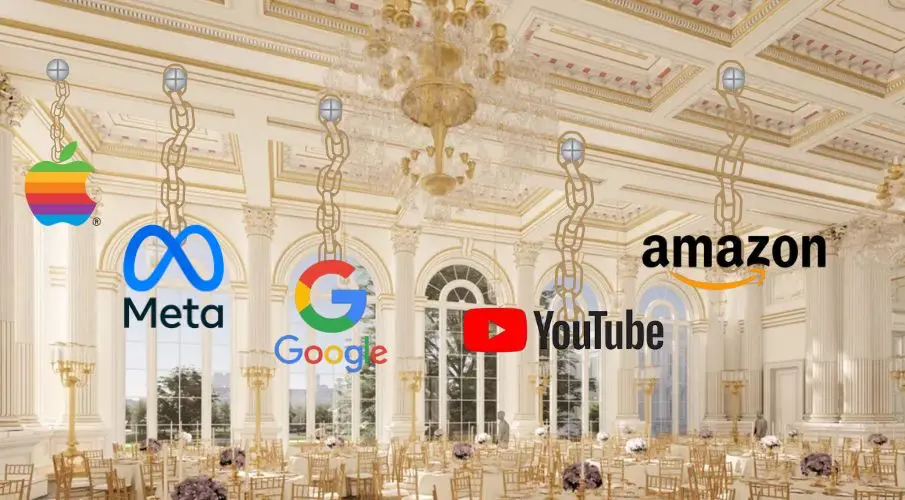What began as an architectural whim has long since become a political scandal with explosive potential. Behind the demolition of the historic East Wing of the White House lies no harmless renovation, but a massive construct of financing and power. Our investigations within the MAGA sphere and internal documents paint a picture in which political influence, economic interest, and personal vanity overlap in dangerous ways. The real cost of the project, contrary to repeated official claims, is not 230 million dollars but, according to the calculations available to us, between 280 and 300 million dollars.

Money talks—and decides. The principle is as simple as it is explosive: Instead of following the usual path through budget appropriations and congressional oversight, the White House asked major donors directly for checks. The published donor list includes the usual Republican megadonors, but what stands out is the presence of companies whose business interests are directly tied to decisions made by the administration—telecom firms, shipping and railway companies, financial funds. And the absence of the big tech names is only partial: Google, Apple, Microsoft, Amazon, and Meta appear throughout in various connections, and internal briefings indicate that several of these companies are believed to have made substantial contributions. One well-known case is YouTube: 22 million dollars were transferred as part of a settlement.

The mechanism is transparent. Companies seeking approvals, mergers, or regulatory leniency have little interest in risking the anger of a president who commands, threatens, and publicly humiliates. In the case of Union Pacific, for example, a multibillion-dollar merger is at stake, and a friendly ear in the White House is worth its weight in gold. For the tech giants, the issue is market access, infrastructure rights, and above all, artificial intelligence - a field in which government decisions translate directly into billion-dollar outcomes. One could argue that philanthropy is part of political culture. But here the gray area ends and the obvious conflict of interest begins: the president asks the largest players in the U.S. economy to finance his private reception hall, and the corporations he regulates respond with payments. The Trust for the National Mall serves as intermediary, so that the money does not officially go directly to the White House. Formally, everything may appear clean - but in practice, the arrangement creates dependencies that undermine democratic oversight.

Politically, the damage is twofold: internally, the project is pulling the administration apart; externally, it fuels the narrative of a ruling caste able to buy state purpose and personal indulgence. Employees at the Treasury Department have reportedly been instructed not to take photos of the construction site. The images of the demolished East Wing nevertheless circulate, and they are not only an aesthetic loss - they are a symbol. Legally, several questions remain open. Who has access to the contracts between donors and the trust? What commitments were made in return? Were construction and procurement contracts awarded to companies that pledged donations? These are questions that, in another political climate, would trigger investigations. In Washington, however, the debate currently unfolds on two levels: a moral one, which voices outrage over the blatant conflict of interest, and a strategic one, in which allies defend the affair as legitimate and unproblematic.
Here are the companies donating to Trump’s White House ballroom:
- Altria Group
- Amazon (Amazon founder Jeff Bezos owns the Washington Post)
- Apple
- Booz Allen Hamilton
- Caterpillar
- Coinbase
- Comcast Corporation
- Hard Rock International
- Google (22 million dollars came from a settlement Trump reached with Google-owned YouTube)
- HP
- Lockheed Martin
- Meta Platforms
- Micron Technology
- Microsoft
- NextEra Energy
- Palantir Technologies
- Ripple
- Reynolds American
- T-Mobile (the company said it had donated to the Trust for the National Mall but had “no role in the use of those funds”)
- Tether America
- Union Pacific Railroad
What remains is the economy of proximity: those close to the president gain markets, contracts, and favor; those who resist risk retribution. In this sense, the ballroom is not just a space for celebrations. It is an instrument through which a president immortalizes his presence in stone, marble, and balance sheets - financed by those who depend on his decisions. Democracy pays the price in the currency of trust. And that is the real issue: not the color of the carpet, not the size of the chandelier, but the message emanating from a state in which the gap between public office and private gain has grown so wide that corporations now fill it. When a president adorns his residence with donations from the powerful, it changes the rules of the game. Whether the law intervenes is a question for jurists. Whether it withstands public decency is a question for citizens.
Investigative journalism requires courage, conviction – and your support.
Please also strengthen our journalistic fight against right-wing populism and human rights violations. We do not want to finance ourselves through a paywall so that everyone can read our research – regardless of income or origin. Thank you very much!


Mit diesem Ballsaal macht er eigentlich fest, dass es keine wirklichen Wahlen mehr geben wird. Denn, bis der Ballsaal fertig ist, ist seine Amtszeit rum…und dann?
..dass kann er vergessen, selbst die variante jd vance als präsidenten zu küren, der dann zurücktritt uhd trump springt ein, ist nicht umsetzbar
Bitte die Quellen nennen, nicht einfach nur die Namen.
Danke für Ihre Nachricht. Sie verwechseln hier investigativen Journalismus mit Agenturjournalismus. Wir sind nicht die, die von anderen übernehmen – wir sind selbst die Quelle oder gehören zu den wenigen Investigativen, die unabhängig zum selben Thema recherchiert haben. Agenturen greifen solche Recherchen später auf oder übernehmen Teile daraus. Genau das ist ja auch Ziel investigativer Arbeit. Entscheidend ist: Das Weiße Haus hat die betreffenden Unternehmen inzwischen selbst bestätigt und eine schriftliche Stellungnahme beziehungsweise eine Liste veröffentlicht. Ich bitte Sie daher, dies zu berücksichtigen – unsere Arbeitsweise hat mit klassischem Agenturjournalismus nichts zu tun, denn wir recherchieren eigenständig.